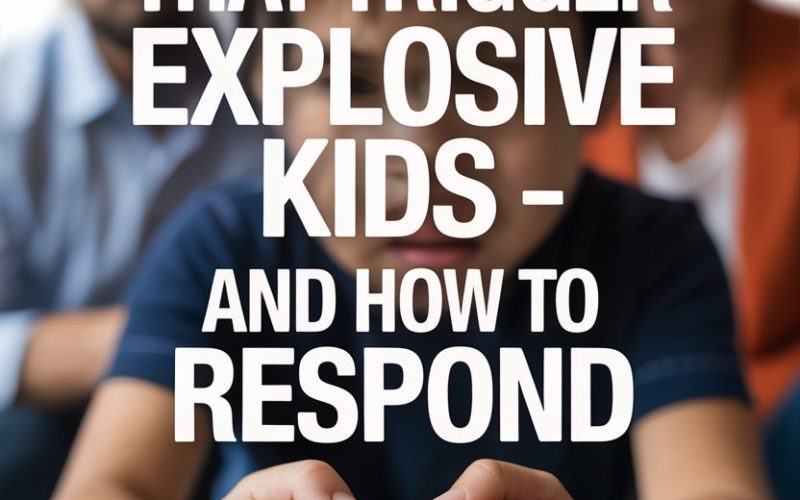Even superheroes have their Kryptonite. For some kids, it’s socks with seams. For others, it’s a sibling breathing in their general direction.
Life with an explosive child can feel like you’re living inside a popcorn machine—just waiting for the next pop.
The triggers can seem mysterious, but a bit of detective work (and a whole lot of patience) can make the difference between a full-blown meltdown and a manageable moment.
Let’s see what sets off those big reactions, and more importantly, what you can do tonight—yes, tonight!—to help your child (and your own sanity).
1. Unexpected Changes Throw Everything Off
Children thrive on predictability, and for many, an unexpected switch-up—like an impromptu trip to Gran’s or a last-minute dinner guest—can feel as stressful as a Monday morning without coffee.
For kids who lean explosive, a sudden change is more than an inconvenience; it’s a total derailment. Their world feels out of control, and their brains sound the alarm: meltdown incoming.
How to Respond:
Cue in your inner fortune-teller. Give your child as much notice as possible about any changes, big or small. Visual schedules, even simple ones drawn on scrap paper, can work wonders.
If you know a transition is unavoidable, try scripting what will happen together.
Offer choices where you can: “We need to leave in ten minutes. Would you like to put on your shoes yourself, or should I help you?” Even a tiny sense of control can help calm the storm.
Dr. Ross Greene, clinical psychologist and author of The Explosive Child suggests collaborative problem-solving—work with your child on plans rather than simply announcing them.
You’ll be surprised how much smoother things run when kids feel included.
2. Sensory Overload: When the World Feels Too Loud, Bright, or Itchy
Picture this: You’re at a birthday party. The room is packed, the music’s blaring, the balloons are squeaking, and your jumper feels like it’s knitted from barbed wire.
Overwhelmed yet? Some kids live life like this every day.
Children who are sensitive to sensory input can become explosive when their brains are bombarded.
This isn’t misbehaviour; it’s biology. Those loud noises, scratchy tags, or even the smell of broccoli steaming in the kitchen can feel like an attack.
How to Respond:
Step one: detective mode. Notice when outbursts happen. Is it always after school? At noisy family gatherings?
Once you spot a pattern, try to reduce triggers—soft clothing, noise-cancelling headphones, or a quiet corner can be game-changers.
When meltdown mode is activated, lower your own voice and keep directions simple. Offer a sensory break: “Would you like to step outside for a bit, or would you prefer your weighted blanket?”
The STAR Institute provides simple strategies for managing sensory processing challenges at home.
And remember—the goal isn’t to remove every trigger (that’s not realistic), but to help your child know their options when things get overwhelming.
3. Hungry, Tired, or Sick: The Triple Threat
No one’s at their best when hungry, exhausted, or feeling poorly. Kids, especially those prone to big reactions, show these discomforts in technicolour.
The result? Outbursts that seem to come from nowhere—but actually have a very real, very physical root.
Think of it as the perfect storm: blood sugar dips; patience dips further.
How to Respond:
Sometimes, all it takes is a banana to stop World War III. Keep snacks handy and don’t underestimate the power of a well-timed sandwich. When tiredness is the culprit, routines matter.
Regular sleep and wake times help set your child’s internal clock, leading to fewer meltdowns.
If illness is brewing, cut everyone some slack. Expectations can shift for the day—less screen time guilt, more cuddles.
And if you ever feel stuck, paediatricians are a great sounding board; they’ve seen every variation on a meltdown known to humankind.
It’s tempting to address just the behaviour, but often the fix is as simple as “Eat this, then we’ll talk.”
4. Feeling Misunderstood or Powerless: The Frustration Factor
You know those days when you’re trying to explain your point, no one listens, and you end up grumbling at the toaster? Kids feel that too—especially if they can’t express what’s bothering them or feel like no one’s on their side.
Explosive reactions often come from feeling powerless or misunderstood. If a child thinks, “No one’s listening!” the volume goes up, literally and figuratively.
How to Respond:
Channel your inner hostage negotiator: reflect, validate, and rephrase. “You’re really angry because you wanted the blue cup, and I gave you the green one. I hear you.”
Sometimes just being heard (even about the blue cup) is enough to take the wind out of a tantrum’s sails.
Give choices within boundaries. “We can’t have biscuits now, but would you like apple slices or grapes?” This shift offers power without caving on your non-negotiables.
Speech and language delays can ramp up frustration. For kids struggling to find their words, try picture charts or sign language.
The Hanley Foundation offers tips for talking with children about their feelings, which can help bridge the gap until words catch up.
5. Big Emotions with No Exit: Bottling Up Until the Explosion
Ever tried shaking a bottle of lemonade, then popping the cap? That’s what happens when kids build up stress, anger, or embarrassment with nowhere for it to go. The result: a fizzy, messy eruption.
Some children aren’t taught (or allowed) to express anger, sadness, or even excitement in healthy ways. Emotions get corked—until they don’t.
How to Respond:
Model what it looks like to handle big feelings. “I’m really frustrated right now, so I’m going to take a few deep breaths.” Or, “When I feel upset, I like to draw for a bit. Want to join me?” You’re not just talking the talk—you’re walking the walk.
Create a “calm-down kit” stocked with favourite books, squishy toys, or drawing supplies. The Child Mind Institute recommends helping kids name their feelings, which can lower the intensity.
When the explosion happens (and occasionally, it will), keep your cool. Safety first. If everyone’s secure, resist the urge to lecture.
Quietly wait it out, then reconnect with a hug or a gentle question when the dust settles. Repair matters more than perfection.
Raising Explosive Kids Without Losing Your Mind
If you’re reading this after fishing a banana out of your hair or negotiating a peace treaty over sock seams, know this: you are not alone.
Even the calmest parents have watched in awe as a small child wins an Oscar for “Best Dramatic Collapse Over Uncut Sandwich.”
Every child is different, and no strategy works every time.
Kids with explosive tempers aren’t “bad”—they’re kids who need a little extra help understanding their triggers and what to do next.
Breathe. Laugh when you can. Offer grace to yourself and your child.
And maybe, stash an emergency chocolate for yourself in the biscuit tin—just in case the next meltdown isn’t theirs, but yours.
Parenting explosive kids isn’t for the faint-hearted, but with empathy, a few practical tricks, and a bucketful of patience, those popcorn moments become less about chaos, and more about connection.





